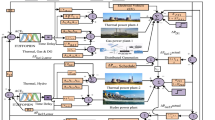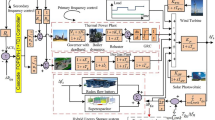Abstract
Due to the erratic nature of renewable sources and repeatedly varying load burdens, variations happening in the execution of AGC is a significant problem concerning deregulated power system (DPS) frequency stability. To solve this, issue demand response (DR) regulation and a hybrid energy storage system (HESS) with a new technique are required. Hence, this paper presents a novel quasi-opposition arithmetic optimization algorithm (QOAOA) optimized cascade interval type-II fuzzy proportional–integral–derivative (IT2FPID)-fractional order PI controller with DR and HESS of super-capacitor and redox flow battery (RFB) for suppressing the variations of frequency and tie-line power in a two-area restructure smart grid system, where the proficiency of the new optimization algorithm (QOAOA) is confirmed by relating its figure of demerit with other present algorithms. Additionally, the supremacy of the suggested IT2FPID-FOPI controller’s implementation is confirmed by competing it with other dominant control strategy. The impact of demand response, load fluctuations, wind speed variations, solar irradiation, and other nonlinearities like the governor dead band (GDB) and generation rate limitation is also evaluated on the analyzed power system with the anticipated controller. Additionally, hybrid energy storage devices containing super-capacitor and redox flow batteries are integrated to study the impact on system dynamics and report higher occurrence. Sensitivity analysis exposes that the QOAOA—improved proposed controller estimated at minimal circumstances is capable of handling significant changes in the system conditions and parameters. Conclusively, by utilizing OPAL-RT, a real-time hardware-in-the-loop (HIL) simulation is estimated to approve the practical feasibility of the suggested controller for the AGC challenge in the smart grid scenario.





















Similar content being viewed by others
Abbreviations
- EVS :
-
Electric vehicles
- PEVS :
-
Plug-in electric vehicle
- GRC:
-
Generation-rate constraint
- PHEVs:
-
Plug-in hybrid electric vehicles
- GDB:
-
Governor-dead-band
- SOC:
-
State of charge
- P max :
-
Maximum power
- P min :
-
Minimum power Gc1 = Transfer function of system 1, Gc2 = Transfer function of system 2
- TLBO:
-
Teaching learning base optimization
- WHO:
-
Whale optimization
- ABC:
-
Artificial bee colony
- PSO:
-
Particle swarm optimization
- SLD:
-
Step load disturbance
- I :
-
Integral
- PI:
-
Proportion integral
- PD:
-
Proportional–derivative
- PID:
-
Proportional–integral–derivative
References
Abualigah L, Diabat A, Mirjalili S et al (2021) The arithmetic optimization algorithm. Comput Methods Appl Mech Eng 376:113609. https://doi.org/10.1016/j.cma.2020.113609
Abubakr H, Mohamed TH, Hussein MM et al (2021) Adaptive frequency regulation strategy in multi-area microgrids including renewable energy and electric vehicles supported by virtual inertia. Int J Electr Power Energy Syst 129:106814. https://doi.org/10.1016/j.ijepes.2021.106814
Aliabadi SF, Taher SA, Shahidehpour M (2018) Smart deregulated grid frequency control in presence of renewable energy resources by EVs charging control. IEEE Trans Smart Grid 9(2):1073–1085. https://doi.org/10.1109/TSG.2016.2575061
Anand A, Aryan P, Kumari N, Raja GL (2022) Type-2 fuzzy-based branched controller tuned using arithmetic optimizer for load frequency control. Energy Sources, Part A Recover Util Environ Eff 44(2):4575–4596. https://doi.org/10.1080/15567036.2022.2078444
Arya Y (2018) Improvement in automatic generation control of two-area electric power systems via a new fuzzy aided optimal PIDN-FOI controller. ISA Trans 80:475–490. https://doi.org/10.1016/j.isatra.2018.07.028
Aryan P, Raja GL (2022) Design and analysis of novel QOEO optimized parallel fuzzy FOPI-PIDN controller for restructured AGC with HVDC and PEV. Iran J Sci Technol—Trans Electr Eng. https://doi.org/10.1007/s40998-022-00484-7
Bao YQ, Li Y (2014) Optimal design of demand response in load frequency control. In: Asia-Pacific Power Energy Eng Conf APPEEC 2015-March:2–5. doi:https://doi.org/10.1109/APPEEC.2014.7065995
Choudhary R, Rai JN, Arya Y (2022) Cascade FOPI-FOPTID controller with energy storage devices for AGC performance advancement of electric power systems. Sustain Energy Technol Assess 53:102671. https://doi.org/10.1016/j.seta.2022.102671
Debbarma S, Dutta A (2017) Utilizing electric vehicles for LFC in restructured power systems using fractional order controller. IEEE Trans Smart Grid 8(6):2554–2564. https://doi.org/10.1109/TSG.2016.2527821
Dereli T, Baykasoglu A, Altun K et al (2011) Industrial applications of type-2 fuzzy sets and systems: a concise review. Comput Ind 62(2):125–137. https://doi.org/10.1016/j.compind.2010.10.006
Dong L, Zhang Y, Gao Z (2012) A robust decentralized load frequency controller for interconnected power systems. ISA Trans 51(3):410–419. https://doi.org/10.1016/j.isatra.2012.02.004
Fan H, Jiang L, Zhang CK, Mao C (2016) Frequency regulation of multi-area power systems with plug-in electric vehicles considering communication delays. IET Gener Transm Distrib 10(14):3481–3491. https://doi.org/10.1049/iet-gtd.2016.0108
Guha D, Roy PK, Banerjee S (2020) Grasshopper optimization algorithm scaled fractional order PI-D controller applied to reduced order model of load frequency control system. Int J Model Simul 40(3):217–242. https://doi.org/10.1080/02286203.2019.1596727
Kumar Khadanga R, Kumar A, Panda S (2021) Frequency control in hybrid distributed power systems via type-2 fuzzy PID controller. IET Renew Power Gener 15(18):1706–1723. https://doi.org/10.1049/rpg2.12140
Lin YY, Liao SH, Chang JY, Lin CT (2014) Simplified interval type-2 fuzzy neural networks. IEEE Trans Neural Netw Learn Syst 25(15):959–969. https://doi.org/10.1109/TNNLS.2013.2284603
Liu X, Zhao T, Cao J, Li P (2023) Design of an interval type-2 fuzzy neural network sliding mode robust controller for higher stability of magnetic spacecraft attitude control. ISA Trans. https://doi.org/10.1016/j.isatra.2023.01.011
Mahmoud HY, Hasanien HM, Besheer AH, Abdelaziz AY (2020) Hybrid cuckoo search algorithm and grey wolf optimiser-based optimal control strategy for performance enhancement of HVDC-based offshore wind farms. IET Gener Transm Distrib 14(10):1902–1911. https://doi.org/10.1049/iet-gtd.2019.0801
Nandi M, Shiva CK, Mukherjee V (2017) Frequency stabilization of multi-area multi-source interconnected power system using TCSC and SMES mechanism. J Energy Storage 14(4):348–362. https://doi.org/10.1016/j.est.2017.10.018
Nayak N, Mishra S, Sharma D, Sahu BK (2019) Application of modified sine cosine algorithm to optimally design PID/fuzzy-PID controllers to deal with AGC issues in deregulated power system. IET Gener Transm Distrib 13(12):2474–2487. https://doi.org/10.1049/iet-gtd.2018.6489
Patel NC, Sahu BK (2021) Design and implementation of a novel FO-hPID-FPID controller for AGC of multiarea interconnected nonlinear thermal power system. Int Trans Electr Energy Syst 31(11):1–28. https://doi.org/10.1002/2050-7038.13078
Peddakapu K, Srinivasarao P, Mohamed MR et al (2022) Stabilization of frequency in multi-microgrid system using barnacle mating optimizer-based cascade controllers. Sustain Energy Technol Assess 54:102823. https://doi.org/10.1016/j.seta.2022.102823
Prakash A, Murali S, Shankar R, Bhushan R (2018) (2019) HVDC tie-link modeling for restructured AGC using a novel fractional order cascade controller. Electr Power Syst Res 170:244–258. https://doi.org/10.1016/j.epsr.2019.01.021
Rai A, Das DK (2022) The development of a fuzzy tilt integral derivative controller based on the sailfish optimizer to solve load frequency control in a microgrid, incorporating energy storage systems. J Energy Storage 48:103887. https://doi.org/10.1016/j.est.2021.103887
Rangi S, Jain S, Arya Y (2022) Utilization of energy storage devices with optimal controller for multi-area hydro-hydro power system under deregulated environment. Sustain Energy Technol Assess 52:102191. https://doi.org/10.1016/j.seta.2022.102191
Ranjan M, Shankar R (2022) A literature survey on load frequency control considering renewable energy integration in power system: recent trends and future prospects. J Energy Storage 45:103717. https://doi.org/10.1016/j.est.2021.103717
Saha A, Saikia LC (2018) Performance analysis of combination of ultra-capacitor and superconducting magnetic energy storage in a thermal-gas AGC system with utilization of whale optimization algorithm optimized cascade controller. J Renew Sustain Energy. https://doi.org/10.1063/1.5003958
Şahin S, Saffet A (2018) Computation of PI controllers ensuring desired gain and phase margins for two-area load frequency control system with communication computation of PI controllers ensuring desired gain and phase margins for two-area Lo. Electr Power Compon Syst 20(4):1–10. https://doi.org/10.1080/15325008.2018.1509914
Sahu PC, Prusty RC, Panda S (2020) Frequency regulation of an electric vehicle-operated micro-grid under WOA-tuned fuzzy cascade controller. Int J Ambient Energy 0:1–18. https://doi.org/10.1080/01430750.2020.1783358
Saikia LC (2018) Load frequency control of a wind—thermal—split shaft gas turbine—based restructured power system integrating FACTS and energy storage devices. Int Trans Electr Energy Syst 16(October):1–19. https://doi.org/10.1002/etep.2756
Saxena A, Shankar R (2022) Improved load frequency control considering dynamic demand regulated power system integrating renewable sources and hybrid energy storage system. Sustain Energy Technol Assess 52:102245. https://doi.org/10.1016/j.seta.2022.102245
Saxena A, Shankar R, Parida SK, Kumar R (2022) Demand response based optimally enhanced linear active disturbance rejection controller for frequency regulation in smart grid environment. IEEE Trans Ind Appl 9994(c):2–12. https://doi.org/10.1109/tia.2022.3166711
Sharma G, Krishnan N, Arya Y, Panwar A (2021a) Impact of ultracapacitor and redox flow battery with JAYA optimization for frequency stabilization in linked photovoltaic-thermal system. Int Trans Electr Energy Syst 31(5):1–15. https://doi.org/10.1002/2050-7038.12883
Sharma M, Dhundhara S, Arya Y, Prakash S (2021b) Frequency stabilization in deregulated energy system using coordinated operation of fuzzy controller and redox flow battery. Int J Energy Res 45(5):7457–7475. https://doi.org/10.1002/er.6328
Sharma M, Saxena S, Prakash S et al (2022) Frequency stabilization in sustainable energy sources integrated power systems using novel cascade noninteger fuzzy controller. Energy Sources, Part A Recover Util Environ Eff 44(3):6213–6235. https://doi.org/10.1080/15567036.2022.2091693
Shiva CK, Mukherjee V (2016) A novel quasi-oppositional harmony search algorithm for AGC optimization of three-area multi-unit power system after deregulation. Eng Sci Technol an Int J 19(1):395–420. https://doi.org/10.1016/j.jestch.2015.07.013
Shiva CK, Shankar G, Mukherjee V (2015) Automatic generation control of power system using a novel quasi-oppositional harmony search algorithm. Int J Electr Power Energy Syst 73:787–804. https://doi.org/10.1016/j.ijepes.2015.05.048
Siti MW, Tungadio DH, Nsilulu NT et al (2022) Application of load frequency control method to a multi-microgrid with energy storage system. J Energy Storage 52(PA):104629. https://doi.org/10.1016/j.est.2022.104629
Taghvaei M, Gilvanejad M, Sedighizade M (2022) Cooperation of large-scale wind farm and battery storage in frequency control: an optimal Fuzzy-logic based controller. J Energy Storage 46(April 2021):103834. https://doi.org/10.1016/j.est.2021.103834
Zhang XS, Yu T, Pan ZN et al (2018) Lifelong learning for complementary generation control of interconnected power grids with high-penetration renewables and EVs. IEEE Trans Power Syst 33(4):4097–4110. https://doi.org/10.1109/TPWRS.2017.2767318
Author information
Authors and Affiliations
Corresponding author
Appendix
Appendix
1.1 Values of System Parameters
Thermal: N1i = 0.8, N2i = -0.064, Tg1i = 0.08, Tg2i = 0.08, Tr1i = 10, Kr1i = 0.5, Tt1i = 0.3; BD: K3 = 0.92, K1 = 0.095, K2 = 0.85, Kib = 0.03, Trb = 69, Td = 1, Tf = 10; Gas: Cgi = 1, bi=0.049 XGi=0.6, YGi=1.1, TCRi=0.01, TFi=0.239, TCDi=0.2; Power system parameter: Kps1 = 120, Rth = 2.4, Kps2 = 120, B1 = B2 = 0.545, capacity of area 1 Parea1 = 2000 MW, capacity of area 2 Parea2 = 2000 MW, loading on the system = 50%.
Rights and permissions
Springer Nature or its licensor (e.g. a society or other partner) holds exclusive rights to this article under a publishing agreement with the author(s) or other rightsholder(s); author self-archiving of the accepted manuscript version of this article is solely governed by the terms of such publishing agreement and applicable law.
About this article
Cite this article
Ranjan, M., Shankar, R. A Cascade Fractional Type-II Fuzzy Control Approach for Enhancing Frequency Stability in a Smart Grid System with Diverse Energy Resources. Iran J Sci Technol Trans Electr Eng 47, 1537–1560 (2023). https://doi.org/10.1007/s40998-023-00642-5
Received:
Accepted:
Published:
Issue Date:
DOI: https://doi.org/10.1007/s40998-023-00642-5




